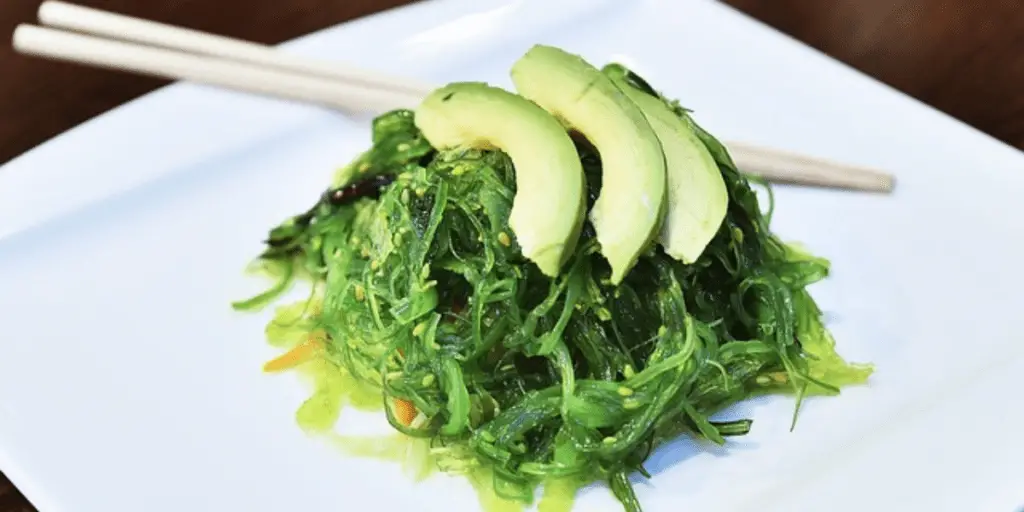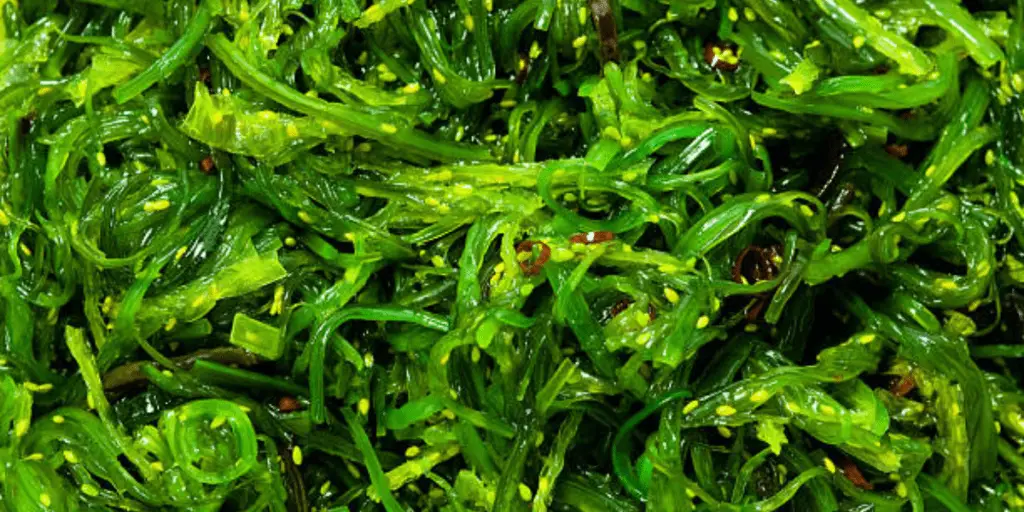A seaweed salad recipe typically includes various types of edible seaweed, such as wakame, hijiki, or kombu, which are commonly used in Asian cuisine. Here’s a general description of a seaweed salad recipe.
Ingredients

- 4 cups of mixed seaweed (such as wakame, hijiki, or kombu)
- 1/4 cup rice vinegar
- 2 tablespoons soy sauce
- 1 tablespoon sesame oil
- 1 tablespoon honey or sugar
- 1 clove garlic minced
- 1 teaspoon grated fresh ginger
- 1/2 teaspoon red pepper flakes (adjust to your spice preference)
- 2 green onions, thinly sliced
- 1 carrot, julienned (optional)
- 1/4 cup toasted sesame seeds
Instructions
1/ Start by rehydrating the seaweed. If you’re using dried seaweed, follow the instructions on the packaging for soaking or boiling. Typically, you’ll want to soak it in cold water for about 10-15 minutes or until it becomes soft and pliable. Drain and rinse the seaweed thoroughly.
2/ In a small bowl, whisk together the rice vinegar, soy sauce, sesame oil, honey or sugar, minced garlic, grated ginger, and red pepper flakes. This will be your dressing.
3/ In a larger bowl, combine the rehydrated seaweed, sliced green onions, and julienned carrot (if using).
4/ Pour the dressing over the seaweed mixture and toss everything together until well coated.
5/ Let the seaweed salad marinate in the refrigerator for at least 30 minutes. This allows the flavors to meld and the seaweed to absorb the dressing.
6/ Before serving, sprinkle toasted sesame seeds on top for added flavor and texture.
7/ Serve the seaweed salad as a side dish or a light, healthy snack.
You can adjust the ingredients and the amount of dressing to suit your taste preferences. This salad is not only delicious but also packed with nutrients from the seaweed.
Some Tips and Tricks

Choose High-Quality Seaweed: Use good-quality seaweed, preferably from a reputable source. Look for seaweed that is clean, free from debris, and has a vibrant color.
Mix Different Seaweeds: Experiment with a combination of seaweed varieties for a more interesting texture and flavor. Common options include wakame, hijiki, kombu, and nori.
Properly Rehydrate Seaweed: Follow the rehydration instructions on the seaweed packaging. Typically, you’ll soak dried seaweed in cold water until it becomes soft and pliable. Rinse it thoroughly after soaking.
Thinly Slice Vegetables: If you’re adding vegetables like green onions or carrots, make sure to thinly slice or julienne them for better distribution and texture in the salad.
Balance the Dressing: Adjust the dressing ingredients to achieve the right balance of flavors. Taste the dressing and modify it according to your preferences – more soy sauce for saltiness, more honey or sugar for sweetness, and more or less red pepper flakes for spiciness.
Marinate for Optimal Flavor: Allow the salad to marinate in the refrigerator for at least 30 minutes before serving.
Use Toasted Sesame Seeds: Toasted sesame seeds add a nutty flavor and crunch. You can toast them in a dry pan over low heat for a few minutes before adding them to the salad.
Don’t Overdress: Be cautious not to overdress the salad. You can add dressing gradually and stop when the seaweed is evenly coated without drowning in excess dressing.
Garnish with Fresh Herbs: For an extra layer of flavor, consider garnishing the salad with fresh herbs like cilantro, mint, or parsley.
Serve Chilled: Seaweed salad is typically served chilled. Keeping it in the refrigerator allows the flavors to meld and the salad to refreshingly cool.
Be Mindful of Allergies: Be aware of any allergies to seaweed or other ingredients among your guests.
Common Mistakes to Avoid

When making seaweed salad, there are some common mistakes to avoid in order to achieve the best flavor and texture. Here are some of the most common errors:
Not Rinsing Seaweed Thoroughly: Failing to rinse the rehydrated seaweed adequately can result in a salad that tastes too salty or has a strong seaweed flavor. Rinse it in cold water multiple times until the water runs clear to remove excess salt and any residual seaweed taste.
Over-Soaking the Seaweed: Be careful not to over-soak the seaweed, as this can make it mushy. Follow the rehydration instructions on the seaweed packaging and use cold water.
Using Stale or Low-Quality Seaweed: The quality of seaweed matters. Using stale or low-quality seaweed can result in an unpleasant texture and taste. Choose fresh, clean, and high-quality seaweed for the best results.
Inadequate Dressing: A common mistake is not making enough dressing or not distributing it evenly throughout the salad. Ensure the seaweed and other ingredients are well-coated for balanced flavor.
Ignoring Marination Time: Allowing the salad to marinate is crucial. Skipping this step can result in a lack of depth in flavor. Give the salad at least 30 minutes to marinate in the refrigerator.
Overdressing: Adding too much dressing can overwhelm the salad and make it overly salty or sweet. Start with a moderate amount and add more as needed, tasting as you go.
Using Unbalanced Flavors: Failing to balance the flavors in the dressing can lead to a salad that’s either too sweet, too salty, or too spicy. Taste the dressing as you prepare it and make adjustments accordingly.
Neglecting Texture: Pay attention to the texture of the salad. It should have a pleasant crunch from ingredients like green onions, carrots, and toasted sesame seeds. Overcooking or over-soaking the seaweed can lead to a mushy texture.
Not Toasting Sesame Seeds: Toasted sesame seeds add a wonderful nutty flavor to the salad. Skipping this step can result in a less flavorful dish.
Serving at the Wrong Temperature: Seaweed salad is traditionally served cold. Serving it at room temperature can affect the overall experience, so make sure it’s properly chilled.
Ignoring Dietary Restrictions: Be mindful of dietary restrictions or allergies your guests may have. Some people may have allergies to seaweed or other ingredients used in the salad.
Nutrition Facts

Seaweed salad is not only delicious but also quite nutritious. Here are some general nutrition facts for a typical serving of seaweed salad, which is approximately 1 cup (about 140 grams):
- Calories: 30-50 calories
- Carbohydrates: 6-10 grams
- Dietary Fiber: 1-2 grams
- Sugars: 2-4 grams
- Protein: 1-2 grams
- Fat: 0-1 gram
Seaweed salad is low in calories and fat, making it a healthy and low-calorie side dish or snack. Here’s a breakdown of some key nutrients found in seaweed salad:
- Vitamins: Seaweed is a good source of vitamins, particularly vitamin A, vitamin C, and several B vitamins, such as folate (B9).
- Minerals: Seaweed is rich in essential minerals like iodine, calcium, iron, magnesium, and potassium.
- Dietary Fiber: Seaweed contains dietary fiber, which can aid digestion and help regulate blood sugar levels.
- Protein: While not a significant source of protein, seaweed does provide a small amount of plant-based protein.
- Antioxidants: Seaweed contains various antioxidants, which can help protect cells from damage caused by free radicals.
- Iodine: Seaweed is particularly high in iodine, a vital nutrient for maintaining thyroid health and regulating metabolism.
- Omega-3 Fatty Acids: Some seaweed varieties contain small amounts of omega-3 fatty acids, which are beneficial for heart and brain health.
Keep in mind that the exact nutritional content of seaweed salad may vary depending on the specific types of seaweed used and the dressing ingredients.






